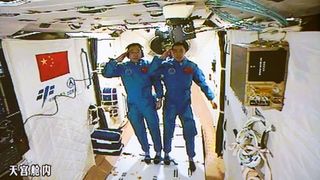China wants to build a new space station. A planned launch in April will set the stage.

China's space program is planning a launch in April to prepare for building the country's next space station.
A Long March 5B rocket will carry a "trial version" of China's new spaceship, which is designed to carry crews of up to six people, state media source Xinhua said. Previous Chinese spaceships carried up to three taikonauts, the term used to describe Chinese astronauts.
While the April mission will carry neither people nor pieces of the future space station, it is expected to prepare Chinese officials for space station construction, the report added.
Related: China readies its new deep-space crew capsule for 1st test flight
The Long March 5B is a modified version of China's heavy-lift Long March 5 rocket, which began flying in 2016. The China Manned Space Agency designed the 5B for the space station and large crewed spacecraft, Xinhua said.
China plans to finish the space station by 2022, after more than 10 missions for construction and in-orbit assembly. The station will be shaped like a T, with a core module, called Tianhe, at the center and one lab capsule on either side of that.
All told, the station will offer up to 5,650 cubic feet (160 cubic meters) of living space across the three modules. That's a little more than one-third of the space on the International Space Station, which has 13,696 cubic feet (388 cubic meters) of room, not including temporary expansions from visiting spaceships.
Get the Space.com Newsletter
Breaking space news, the latest updates on rocket launches, skywatching events and more!
Unlike previous Chinese space stations, which required water launched from Earth, water on the new space station will be recovered from water vapor the astronauts exhale and from urine that is recycled and purified, Xinhua said. This space station will also carry machinery that can produce supplemental oxygen, Xinhua added.
The Chinese space complex will also have room for science experiments in fields ranging from astronomy to basic physics to life science, using more than a dozen experiment racks. China also plans to launch an optical telescope on a capsule flying "in the same orbit," Xinhua said.
China's first space station, the one-room Tiangong-1, launched in 2011 and burned up in Earth's atmosphere seven years later. The vehicle helped China master the technologies and procedures needed to build bigger stations.
A successor, Tiangong-2, launched in 2016 to support longer-duration missions. China's most recent crewed launch, in October 2016, sent two taikonauts to Tiangong-2 for 33 days, a record for consecutive time spent in space for China.
- This is China's new spacecraft to take astronauts to the moon (photos)
- China releases huge batch of amazing Chang'e-4 images from moon's far side
- This is the 1st photo of China's Mars explorer launching in 2020
Follow Elizabeth Howell on Twitter @howellspace. Follow us on Twitter @Spacedotcom and on Facebook.
<a href="https://myfavouritemagazines.pxf.io/c/221109/583111/9620?subId1=hawk-custom-tracking&sharedId=hawk&u=https%3A%2F%2Fwww.myfavouritemagazines.co.uk%2FAAS%2Fspace2020w" data-link-merchant="myfavouritemagazines.co.uk"" target="_blank" rel="nofollow">OFFER: Save at least 56% with our latest magazine deal!
<a href="https://myfavouritemagazines.pxf.io/c/221109/583111/9620?subId1=hawk-custom-tracking&sharedId=hawk&u=https%3A%2F%2Fwww.myfavouritemagazines.co.uk%2FAAS%2Fspace2020w" data-link-merchant="myfavouritemagazines.co.uk"" data-link-merchant="myfavouritemagazines.co.uk"" target="_blank" rel="nofollow">All About Space magazine takes you on an awe-inspiring journey through our solar system and beyond, from the amazing technology and spacecraft that enables humanity to venture into orbit, to the complexities of space science.
Join our Space Forums to keep talking space on the latest missions, night sky and more! And if you have a news tip, correction or comment, let us know at: community@space.com.

Elizabeth Howell (she/her), Ph.D., is a staff writer in the spaceflight channel since 2022 covering diversity, education and gaming as well. She was contributing writer for Space.com for 10 years before joining full-time. Elizabeth's reporting includes multiple exclusives with the White House and Office of the Vice-President of the United States, an exclusive conversation with aspiring space tourist (and NSYNC bassist) Lance Bass, speaking several times with the International Space Station, witnessing five human spaceflight launches on two continents, flying parabolic, working inside a spacesuit, and participating in a simulated Mars mission. Her latest book, "Why Am I Taller?", is co-written with astronaut Dave Williams. Elizabeth holds a Ph.D. and M.Sc. in Space Studies from the University of North Dakota, a Bachelor of Journalism from Canada's Carleton University and a Bachelor of History from Canada's Athabasca University. Elizabeth is also a post-secondary instructor in communications and science at several institutions since 2015; her experience includes developing and teaching an astronomy course at Canada's Algonquin College (with Indigenous content as well) to more than 1,000 students since 2020. Elizabeth first got interested in space after watching the movie Apollo 13 in 1996, and still wants to be an astronaut someday. Mastodon: https://qoto.org/@howellspace

